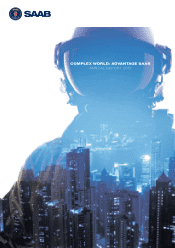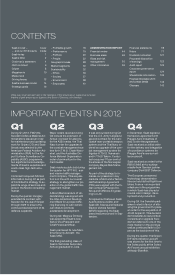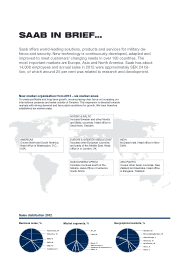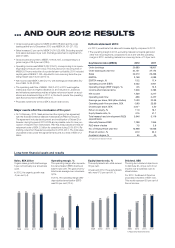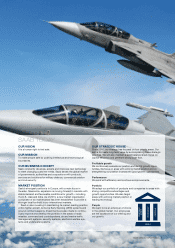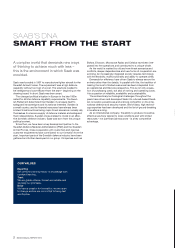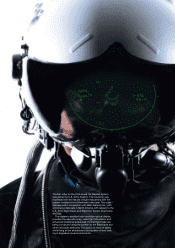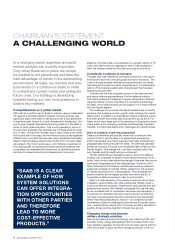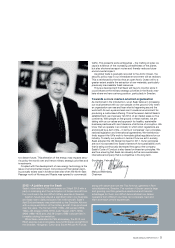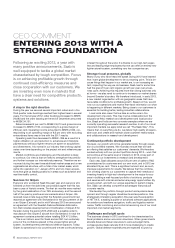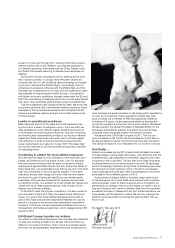Saab 2012 Annual Report Download - page 11
Download and view the complete annual report
Please find page 11 of the 2012 Saab annual report below. You can navigate through the pages in the report by either clicking on the pages listed below, or by using the keyword search tool below to find specific information within the annual report.
SAAB ANNUAL REPORT 2012 7
a total of 10 per cent through 2017, although this trend varies in
different parts of the world. Western countries are expected to
cut defence spending, while areas such as China, Russia, India
and South America are planning to allocate more resources for
defence.
During 2012 we also witnessed a shift in defence policy priori-
ties in some countries. In January 2012 President Obama an-
nounced that the U.S. will modify its defence strategy by increas-
ing focus on Asia and the Pacic Region. Accordingly, the U.S.
will reduce its presence in Europe and the Middle East, and this
imposes new requirements on the way we work together and take
responsibility for shared security within Europe. In combination
with tighter economic conditions, this also means that the EU and
NATO are now talking increasingly about how we can draw benet
from each other and utilise skills and resources more effectively.
This trend presents major opportunities for Saab. We know that
our system solutions offer cost-effective defence solutions. Some
examples of this are advanced systems such as ghter aircraft,
airborne surveillance systems and ground combat weapons like
the Carl-Gustaf.
Leader in operational excellence
Saab has been around for 75 years and is still marked by hav-
ing its roots in a small, non-aligned country. From the start, we
have operated on a very distinct market and this has forced us
to think smart and use resources efciently. This way of thinking
and working also characterises us today in our focus on efcient
operations. Saab employees work every day to achieve greater
cost-efciency in order to deliver products and services with
power, performance and value for money. With “The Saab Way”
as a control instrument, we have excellent prospects to maintain
our advantage here.
Continuing to attract the most skilled employees
We often say that Saab is one of Sweden’s most high-tech com-
panies, and these are not just empty words. I can, for example,
state as concrete evidence that the share of university-trained
employees is approximately 55 per cent (54). And as the father of
three daughters, Iam personally proud that we are one of the best
high-tech companies in terms of gender equality. This is dem-
onstrated, among other things, by the fact that we have nearly
achieved our goal of having at least 30 per cent female senior
executives. Once we have achieved this objective we will raise
our ambition further. Our ambition is to carry these key gures and
values with us as Saab expands abroad, even though circum-
stances vary between markets.
To be able to meet the tougher competition, it is also crucial for
us to be able to attract and retain the market’s best talents and
brains. Our goal is that these skilled employees will be able to
grow within Saab and become inspirational leaders who can be
part of our journey to become an international and competitive
company. To this end, we have developed initiatives such as our
management and trainee programmes, which engaged about 250
people in 2012.
UN Global Compact guides our actions
Our efforts on international expansion also imposes high demands
on everyone working at Saab to be familiar with and remain up-
dated on our Code of Conduct. Trust in us is an invaluable asset
that must not be jeopardised. Business ethics are crucial and we
have therefore put great emphasis on developing strict regulations
on how we do business. These regulations include zero toler-
ance of bribes. As a member of ASD (Aerospace and Defence
Industries of Europe), we are supporting efforts to develop anti-
corruption regulations in the form of Common Industry Standards.
We also support the Global Principles of Business Ethics for the
Aerospace and Defence Industry and efforts to promote these
principles within the global aviation and defence industry.
We adopted the UN Global Compact in 2011. This is a pro-
gramme based on UN human rights principles but which also in-
cludes principles on labour, the environment and anti-corruption.
The Global Compact is now integrated into our Code of Conduct.
And finally …
Gripen’s successes during 2012 clearly illustrate Saab’s competi-
tive advantages: cutting-edge technology, cost-efciency over the
entire lifecycle, high integration and exibility capacity and close
cooperation with customers. The fact that we at Saab have been
working smartly and cost-efciently since our start 75 years ago
will be increasingly important during times of dwindling resources.
We received concrete evidence of this in the form of increased
order bookings during the year. With this background, we have a
solid platform for protable growth in 2013.
During times of change within a company, major strain is put
on its employees. All of us at Saab have worked hard to achieve
ambitious goals. I want to thank everyone who is involved in im-
plementing our strategy, everyone who shares our belief in the fu-
ture and everyone who wants to develop Saab into the important,
successful company it deserves to be. As I mentioned above, we
have already put the platform in place. We will now manage this
platform and ensure that it produces the gearing effect that we
know it can.
Stockholm, February 2013
Håkan Buskhe
President and CEO

